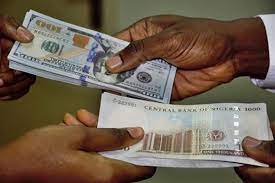
The Nigerian currency breached the N1,450 mark against the greenback on the black market amid evolving market dynamics in Nigeria’s fragile FX market.
Market fundamentals affirm that the naira lost its support at N1450, setting up a new wave of free decline, continuing its downward trend from March, when it was previously praised as the world’s best-performing local currency. Recent price action shows the naira within striking distance of N1500 against the haven currency.
On the black market, the naira fell to a month-low of 1,470 against the dollar on Friday amid high demand for the greenback. Market analysts have long maintained that without a corresponding policy move by the fiscal side, the local currency would be unable to hold its year-to-date gains.
Nigeria’s oil output, a major source of FX earnings, has been on the slope, highlighting the significance of diversifying the economy and cutting FX liabilities.
CBN’s recent data showed a sizable portion of $1.12 billion out of the $1.61 billion in total outflows made during this time went toward paying off external debt, rather than defending the naira, underscoring the mounting strain that foreign debt is placing on the country’s budget and the local currency market.
As a result, the FX market in the nation will look for additional support as the CBN is expected to stick with its hawkish narrative and raise the headline interest rate at its upcoming monetary policy meeting on May 21.
The CBN made significant progress by clearing actual FX backlogs and amplifying rates to attract FPIs and keep the local money market more attractive; however, profit-taking and a slowdown in inflows obscured this success.
Standard Chartered’s top economist for Africa and the Middle East, Razia Khan, stated in an interview that about $1.3 billion of naira futures are set to mature at the end of this month, which could potentially depress the country’s FX market.
According to Khan, “It is believed that this will increase demand for dollars. Offshore investors made a profit when the currency appreciated quickly.”
The dynamics of the naira have become further complicated as the dollar index edged higher despite signs of slowing U.S. economic growth. The dollar index, which gauges the strength of the US dollar against a basket of six rival currencies, increased by 0.07% to 105.29 index points. The yen fell 0.17% to 155.74 per dollar, while the euro fell 0.1% to $1.077.
The Bank of England’s announcement on Thursday, suggesting that rate cuts might begin as early as next month, coupled with data indicating the British economy emerged from a minor recession, gave dollar bulls enough room to maintain the upside momentum.
Investors now await clues indicating that U.S. inflation has started to decline back toward the Federal Reserve’s goal rate of 2% in both the producer price index and the consumer price index for next week.
April’s inflation figures, which were hotter than expected, dashed any residual expectations of a near-term U.S. interest rate cut. The likelihood of the Fed acting in September has decreased, and markets are now fully pricing in a cut only in November.






